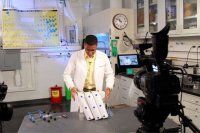Flipping This Class: A Journey from Professor to Popularizer
I was an unusual little girl. Since I was four, I wanted to be a scientist. I got the idea from a television show called 3-2-1 Contact.
From my experience, I learned that exposure to fun science is the best pathway to encourage children to learn. For this reason, I created a fun science show for kids at Yale called Science Saturdays. For the Saturdays of April and October, children converge on New Haven, Connecticut, where they are exposed to the Three D's: Donuts, Demonstrations, and Dynamic Lectures.
Since 2004, hundreds of children from as far away as New Jersey and Boston have visited; the only cost is an inquisitive mind. Topics range from “Why Birds are Dinosaurs” to “Finding Human History in Your Spit.” (We learned that the grosser the topic, the larger the audience; and that lectures about dinosaurs become standing room only.)
If you aren't near New Haven, fear not. These lectures are recorded and streamed from the website. You can also find a free downloadable science demonstration guide there called Demoworks, which teachers rave about.
Capturing a New Audience
After eight years of directing Science Saturdays, I made the leap to become a science evangelist and follow in the footsteps of Isaac Asimov, Carl Sagan, Bill Nye and Neil Tyson to get the general public excited about science. To do so, I needed to broaden my reach. So, last year I started producing a series of science videos called Material Marvels that are free on iTunes and YouTube. These three-minute videos highlight cool materials with strange properties.
I learned a lot in creating these videos during my transformation from professor to popularizer. You see, in a classroom, we have a captive audience. We can give a boring lecture and the students are not going anywhere. However, YouTube videos must compete for a student's attention. They are probably media-multitasking (i.e. updating their Facebook status and tweeting at the same time), so you've got to make the videos compelling.
Fortunately, materials science is engaging in nature because many demonstrations require a blowtorch. Lethal demonstrations are a big attention-grabber! Well, I had a hook, but that wasn't enough.
I also learned that the demonstrations had to be at the top of the video. In my earliest videos, I introduced the topic, showed a demonstration, and then discussed the material's relevance -- just like my lecture. All those parts are needed to engage, but the order was wrong. I had to flip it.
In a science video, you have to hook an audience first. So my current videos start with the demonstration, then I introduce the topic. I'll pepper in another demonstration and then discuss the relevance of the material. You have to hook and then re-hook the audience because they can "change the channel" at any time.
Framing the Lesson
I also learned that videos need to be short and engaging. Many of my scientist colleagues get this wrong. They are pretty much filming their dry lecture with a video camera. What they are forgetting is that all this information is on the web already, so they need to add something that the web does not have -- and that is the human element.
When teaching via videos, we have to add personality and passion. Viewers are continuously asking, "Why should I be watching you?" And the answer is not, "Because I have this information." Information is a commodity. What professors and instructors can do (and already have the market on doing) is framing. Human instructors can show the story behind the lesson, show enthusiasm and infect their audiences with their delight for the topic.
A flipped class is more than lectures by night and learning by day. That is certainly a paradigm shift, but a flipped class has the side benefit of improving how we lecture. It forces us to engage in order to compete for a student's attention.
When a video is produced well, it has the potential to impact many minds. My video on Graphene (see below) was posted on Scientific American and got 16,000 hits. That is a very modest number compare to viral video stats. However, 16,000 eyeballs are more than I would have gotten in a career as a professor; and many of the viewers might never have thought this topic was something they could understand. Science videos conquer many barriers to science learning, such as access, understandability and reach.
President Kennedy had a mission to get us to the moon; my mission is to get all children access to rich, engaging and fun science lessons. A flipped class and its accompanying science videos is the path to do it. It is my plan to get kids excited about science three minutes at a time.
